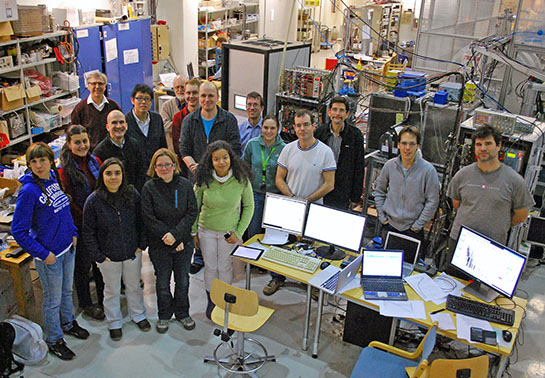Measuring for the first time the disintegration of one of the main products of nuclear fission
- Science Park
- May 30th, 2019

Researchers from the Institute of Corpuscular Physics (Instituto de Física Corpuscular) publish in Physical Review Letters the study of the beta disintegration of isotopes of niobium, one of the most unknown elements in the functioning of a nuclear reactor.
Nuclear fission, a reaction that divides the atomic nucleus and is used in nuclear power plants to produce energy, also produces other radioactive elements. To seek stability, these elements carry out the so-called beta disintegration, a fundamental process for understanding what happens inside a nuclear reactor, even when it is turned off. Now, researchers from the Institute of Corpuscular Physics (IFIC, CSIC-Universitat de València) are publishing in Physical Review Letters the first complete study on the beta disintegration of two isotopes of niobium, an important element to know how a nuclear reactor works and one of the most difficult to measure. To do so, they have used a detector and an analysis method devised in València.
The study is part of Víctor Guadilla's doctoral thesis, directed by IFIC researchers Alejandro Algora and José Luis Taín, from the Gamma and Neutron Spectroscopy Group. They used the DTAS detector, an instrument designed by this research group formed by 18 sodium iodide crystals that functions as a calorimeter, recording the gamma spectrum emitted during beta disintegration.
One of the main difficulties of the study was to obtain a particle beam of the isotopes of interest of niobium, an extremely resistant refractory metal. For this purpose, the Valencian researchers used the IGISOL IV facility at the Finnish laboratory in Jyväskylä, equipped with several ion 'traps' that allowed them to create a 'pure' niobium beam.
Using the technique known as Total Absorption Gamma Spectroscopy (TAGS), IFIC scientists obtained for the first time the beta disintegration spectrum of several isotopes of niobium (100Nb and 102Nb), one of the most important elements in the beta disintegrations associated with the nuclear fission process. In addition, it is one of the most unknown nuclei precisely because of the difficulties for its study.
"For each fission process there are 6 beta disintegrations", explains Alejandro Algora, one of the authors of the study. "Knowing the spectrum of beta disintegration of niobium is important to better understand its role in processes such as the residual heat generated by beta disintegrations, which affects the materials of the nuclear reactor once 'turned off', and the production of antineutrinos in nuclear power plants"
This last aspect has an important impact on the study of neutrino, one of the most abundant elementary particles in the Universe that hardly interacts with the rest of the matter. In each beta disintegration an antineutrino is produced, its replica of antimatter, reason why the nuclear reactors are an abundant source of these particles. Thus, one of the main ways to study them is to place detectors near nuclear power plants.
"In this type of study, it is essential to know precisely how many antineutrinos you expect to detect," says Algora. This amount can be obtained in two ways: by extrapolating measurements of the total beta spectrum emitted by the most relevant fuels (uranium, plutonium...) after fission, or by adding the spectra of the beta disintegration of each fission product. By obtaining the spectra of beta disintegration of niobium for the first time, IFIC researchers provide valuable information to improve knowledge of the production of antineutrinos by the latter method.
"With our data, the discrepancy between the calculations of the antineutrinos spectrum elaborated by the sum method and the expected neutrinos flux observed in several experiments is reduced in a remarkable way", assures Algora. It refers to reported results obtained by detectors located near nuclear power plants in France (Double Chooz), China (Daya Bay) and South Korea (RENO), which captured less antineutrinos than expected. Some explain this deficit by the existence of a new type of yet undiscovered neutrino that does not interact with matter, the 'sterile' neutrino. The new results from the València group weaken this hypothesis.
More information:
“Large Impact of the Decay of Niobium Isomers on the Reactor ¯νe Summation Calculations”, V. Guadilla et al., Phys. Rev. Lett. 122, 042502
More information:
















